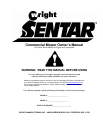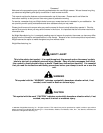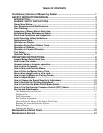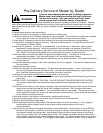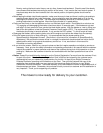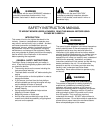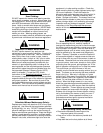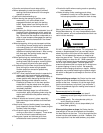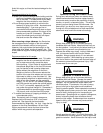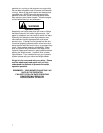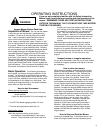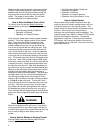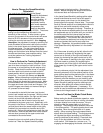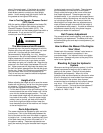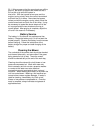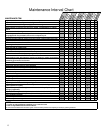
5
• Know the controls and how to stop quickly.
• Before attempting to start the engine, follow all
starting instructions below and in the engine
operator’s manual.
• Look behind before backing up.
• Before leaving the operator’s position, even
momentarily, turn off the blade clutch
engagement switch and apply the parking
brake. Keep others from coming near the
mower. Get back on the mower as soon as
possible.
• When leaving the Wright mower unattended, turn off
the blade clutch engagement switch, apply the
parking brake, stop the engine and remove the
key. Never leave the machine unattended on a
slope in case someone disengages the parking
brake which would be hazardous if the mower
were to roll.
• When transporting, driving onto transport vehicles,
into buildings, across parking lots or otherwise
not mowing grass, turn off the blade clutch
engagement switch to reduce risk of thrown
objects and rotating blade hazard. After coming
to a stop apply the parking brake, stop the
engine and remove the key.
• Before performing any maintenance or repair
service, disengage power to blades, apply the
parking brake, stop the engine, remove ignition
key and spark plug wire from spark plug(s).
• All operators of this mower should exercise caution
when driving this mower at high speeds.
Sudden stops from excessive speeds may
cause serious injury.
• DO NOT allow inexperienced people to operate the
mower until they have read and understood
these safety instructions. Operate the mower at
slower speeds while becoming familiar with it.
• The grass discharge chute deflector must be
installed at all times and in the down position
except that it may be raised when the grass
catcher is completely installed or a mulch kit is
completely installed.
• If the mower discharge clogs, turn off the blade
clutch switch, apply the parking brake, stop the
engine and remove the key before removing
obstruction.
• Keep all shields and covers in place, especially
grass discharge chute deflector and the blade
belt covers.
• Keep hands, feet and clothing away from rotating
parts, especially the rear wheels, blades, engine
flywheel, belts and pulleys.
• Do not touch engine or muffler while engine is
running or soon after it is stopped. These areas
can be so hot as to cause severe burns.
• Clean grass, leaves and lubricant spills from
surfaces after use to prevent fire hazard.
• Be alert for traffic when crossing roads or operating
near roadways.
• Before climbing curbs, crossing gravel drives,
sidewalks or roads, turn off the blades, lift them
into transport position, and wait for them to stop.
WARNING
Replacement Parts:
Use of parts other than specified parts supplied by
Wright Manufacturing, Inc. may compromise the safe
use of the mower, are not recommended and their use
could void the warranty.
WARNING
Operation on Slopes:
DO NOT operate on steep slopes. Do not operate the
mower on slopes steeper than you can feel secure
about the traction of the tires and the stability of the
mower. Do not operate the mower on slopes at all
when the grass is wet. There is a danger of suddenly
sliding sideways or down the hill. When operating on
a slope, travel across the grade whenever possible,
not in an up or down pattern. Reduce speed and
exercise extreme caution on slopes and in sharp turns
to prevent tipping or loss of control. Be especially
cautious when changing direction on slopes. Heavier
operators may consider obtaining the optional weight
bar which is designed to add weight to the front of the
machine.
When pointing up a slope, the Sentar has the most
weight on the drive wheels and therefore the most
traction at the tires. However, this is the angle that it
has the most tendency to tip back (“pop a wheelie.”)
This is the preferred angle for mowing small areas of
steeper slopes.
Recommendations for this angle:
• Lean as far forward as possible and stand if
necessary to add your weight to the front of the
mower.
• Accelerate gently. Do not accelerate quickly to
avoid “popping a wheelie”.
• If backing down the hill, do not stop suddenly but
slow down gradually.
When pointing down a slope, the Sentar has the
least weight on the rear drive wheels and therefore
the least traction at the tires. This is the angle that the
mower has the most tendency to slide. However, this
is the angle that it has the least tendency to tip back.



